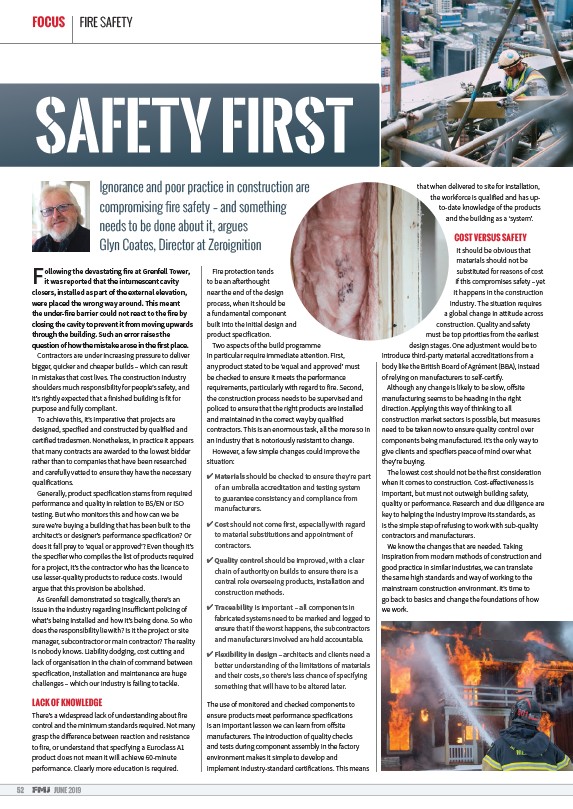
FOCUS FIRE SAFETY
Following the devastating fire at Grenfell Tower,
it was reported that the intumescent cavity
closers, installed as part of the external elevation,
were placed the wrong way around. This meant
the under-fire barrier could not react to the fire by
closing the cavity to prevent it from moving upwards
through the building. Such an error raises the
question of how the mistake arose in the first place.
Contractors are under increasing pressure to deliver
bigger, quicker and cheaper builds – which can result
in mistakes that cost lives. The construction industry
shoulders much responsibility for people’s safety, and
it’s rightly expected that a finished building is fit for
purpose and fully compliant.
To achieve this, it’s imperative that projects are
designed, specified and constructed by qualified and
certified tradesmen. Nonetheless, in practice it appears
that many contracts are awarded to the lowest bidder
rather than to companies that have been researched
and carefully vetted to ensure they have the necessary
qualifications.
Generally, product specification stems from required
performance and quality in relation to BS/EN or ISO
testing. But who monitors this and how can we be
sure we’re buying a building that has been built to the
architect’s or designer’s performance specification? Or
does it fall prey to ‘equal or approved’? Even though it’s
the specifier who compiles the list of products required
for a project, it’s the contractor who has the licence to
use lesserquality
products to reduce costs. I would
argue that this provision be abolished.
As Grenfell demonstrated so tragically, there’s an
issue in the industry regarding insu€ icient policing of
what’s being installed and how it’s being done. So who
does the responsibility lie with? Is it the project or site
manager, subcontractor or main contractor? The reality
is nobody knows. Liability dodging, cost cutting and
lack of organisation in the chain of command between
specification, installation and maintenance are huge
challenges – which our industry is failing to tackle.
LACK OF KNOWLEDGE
There’s a widespread lack of understanding about fire
control and the minimum standards required. Not many
grasp the di€ erence between reaction and resistance
to fire, or understand that specifying a Euroclass A1
product does not mean it will achieve 60minute
performance. Clearly more education is required.
52 JUNE 2019
Fire protection tends
to be an a– erthought
near the end of the design
process, when it should be
a fundamental component
built into the initial design and
product specification.
Two aspects of the build programme
in particular require immediate attention. First,
any product stated to be ‘equal and approved’ must
be checked to ensure it meets the performance
requirements, particularly with regard to fire. Second,
the construction process needs to be supervised and
policed to ensure that the right products are installed
and maintained in the correct way by qualified
contractors. This is an enormous task, all the more so in
an industry that is notoriously resistant to change.
However, a few simple changes could improve the
situation:
Materials should be checked to ensure they’re part
of an umbrella accreditation and testing system
to guarantee consistency and compliance from
manufacturers.
Cost should not come first, especially with regard
to material substitutions and appointment of
contractors.
Quality control should be improved, with a clear
chain of authority on builds to ensure there is a
central role overseeing products, installation and
construction methods.
Traceability is important – all components in
fabricated systems need to be marked and logged to
ensure that if the worst happens, the subcontractors
and manufacturers involved are held accountable.
Flexibility in design – architects and clients need a
better understanding of the limitations of materials
and their costs, so there’s less chance of specifying
something that will have to be altered later.
The use of monitored and checked components to
ensure products meet performance specifications
is an important lesson we can learn from o€ site
manufacturers. The introduction of quality checks
and tests during component assembly in the factory
environment makes it simple to develop and
implement industrystandard
certifications. This means
that when delivered to site for installation,
the workforce is qualified and has uptodate
knowledge of the products
and the building as a ‘system’.
COST VERSUS SAFETY
It should be obvious that
materials should not be
substituted for reasons of cost
if this compromises safety – yet
it happens in the construction
industry. The situation requires
a global change in attitude across
construction. Quality and safety
must be top priorities from the earliest
design stages. One adjustment would be to
introduce thirdparty
material accreditations from a
body like the British Board of Agrément (BBA), instead
of relying on manufacturers to selfcertify.
Although any change is likely to be slow, o€ site
manufacturing seems to be heading in the right
direction. Applying this way of thinking to all
construction market sectors is possible, but measures
need to be taken now to ensure quality control over
components being manufactured. It’s the only way to
give clients and specifiers peace of mind over what
they’re buying.
The lowest cost should not be the first consideration
when it comes to construction. Coste
€ ectiveness is
important, but must not outweigh building safety,
quality or performance. Research and due diligence are
key to helping the industry improve its standards, as
is the simple step of refusing to work with subquality
contractors and manufacturers.
We know the changes that are needed. Taking
inspiration from modern methods of construction and
good practice in similar industries, we can translate
the same high standards and way of working to the
mainstream construction environment. It’s time to
go back to basics and change the foundations of how
we work.
Ignorance and poor practice in construction are
coPpUoPisinJ fi Ue saIety Ɔ and soPetKinJ
needs to be done about it, argues
*lyn &oates 'iUectoU at =eUoiJnition